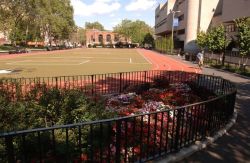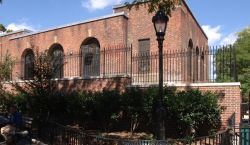Sara D. Roosevelt Park
Rivington Street Playground
This playground, along with the adjacent street honors London born James Rivington (1724-1802), gambler, bookseller, rumored spy and publisher of the Royalist Gazette, a loyalist newspaper, during the American Revolution.
Fleeing England after amassing considerable debt due to extravagant tastes and a penchant for playing the horses at the Newmarket Race Track, James Rivington and his wife, Elizabeth Mynshull, arrived in Philadelphia in 1760. He opened bookshops in Philadelphia, Boston, and New York City, and by 1765, Rivington moved from Philadelphia to concentrate his business in New York City. His first wife most likely died giving birth to his son James in 1769, and, within the year, Rivington married Elizabeth Van Horne, a wealthy New York widow and future mother of his sons Henry (1770) and John (1773).
In March 1773, Rivington began publication of Rivington’s New York Gazetteer. Published out of his shop on Queen and Wall Streets, the Gazetteer, in the words of its publisher sought “…every particular that may contribute to the improvement, information and entertainment of the public,” and he also held that “…no personal satire, and acrimonious censures on any society or class of men shall ever stain this paper.” His ideals were quickly subsumed by the swirling chaos of the coming American Revolution.
The newpaper became a prime venue for the political rantings of patriots and loyalists alike. The Tea Tax, the troubles in Boston, all were hotly debated in his pages. Rivington was politically conservative, and he had no sympathy for those he called “the Sons of Freedom,” but as late as 1774 he still maintained “a printer of a newspaper ought to be neutral where his own press is employed.” However, by 1775, Rivington began to shift the tone of his paper toward an openly pro-British slant, making him the target of American patriot criticism.
Issac Sears, a prominent Patriot called Rivington “a servile tool, ready to do the dirty work of any knave who purchases.” Organized boycotts were launched against Rivington in an attempt to destroy him financially. Patriots in Freehold, New Jersey declared him “a base and malignant enemy to the liberties of this country.” With the American occupation of the City in 1775, Rivington fled to the safety of British ships in New York Harbor. He briefly went back to London, and returned to New York in 1777 after the British regained control.
While the British occupied the City during the Revolutionary War, this street was named by the occupation authorities as a reward for Rivington’s loyalist sympathies. Rivington was appointed King’s Printer for New York, and in October 1777, he began printing his paper again as the Royal Gazette with the help of English funds. The paper quickly changed its name once more to the New York Loyal Gazette; its purpose: to print explicit Brittish propaganda in order to undermine the American cause.
There is a bit of mystery about Rivington’s life in this period, for some scholars maintain that Rivington was also secretly helping the Americans. Aides to George Washington, when interviewed long after the war, held that Rivington (seeking money due to his lack of payment by the British) passed on descriptions of British fleet signals to American agents. The street retained its name following the end of the war in 1783 after Rivington publicly renounced his old beliefs and accepted the rule of the new American order. In 1797, Rivington was confined to a debtors prison because of the obligations he assumed on behalf of his sons’ ventures in East India trade. He was released in January 1801, and died in New York on July 4, 1802.
This parkland was acquired by the City in 1929 for the purpose of widening Chrystie and Forsythe Streets and building low-cost housing but was later set aside for “playgrounds and resting places for mothers and children.” The construction of Sara D. Roosevelt Park, including his playground in 1934 was the largest park project on the Lower East Side since the acquisition of Tompkins Square Park a century earlier.
Check out your park's Vital Signs
Clean & Safe
Green & Resilient
Empowered & Engaged Users
Share your feedback or learn more about how this park is part of a
Vital Park System










